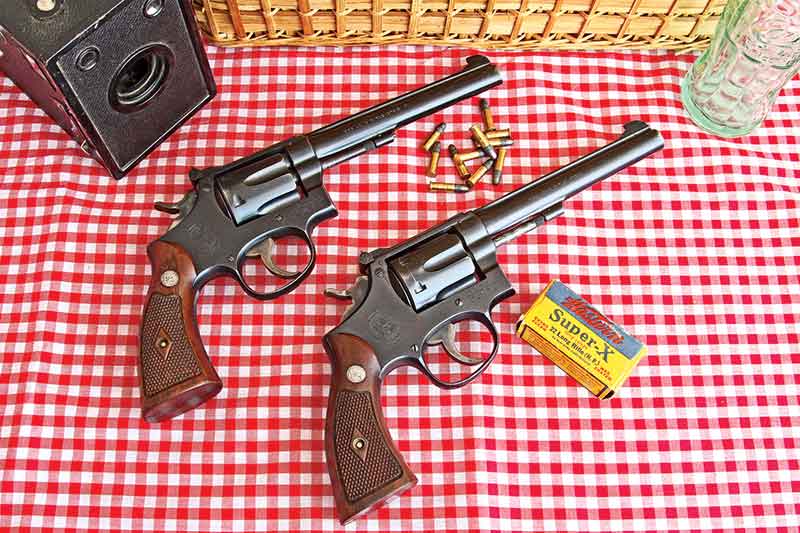Start ’Em Out Right
If you’re reading this, you’re likely a pretty decent shot, a supporter of gun rights, a responsible gun owner and a good ambassador for shooting. In other words, a fairly representative Handgunner reader.
Sooner or later, family members, coworkers, or friends, are going to hesitantly ask if you wouldn’t mind taking them out to try a few shots. You might refer them to a local gun club, or an NRA instructor — and eventually that’s where they should be. But their first step is, “Hey, I’ve never fired a handgun, mind if I try a shot or two?”
It may not be apparent, but you have a big responsibility. You might be starting a new shooter on the way to being an enthusiastic competitor, maybe someone who can capably and responsibly defend home and family. Or you can turn them away from shooting forever.
Let’s take it for granted, firearm safety, eye and ear protection and responsible gun handling are basic. You also want to make a positive first impression. One way to do it is by the choice of firearm. I see people, with the best intentions in the world, make the first shooting experience unpleasant.
Too Much Gun
I’m a believer in a .22 rimfire, with standard velocity ammunition, as a training tool. Still, not everyone wants or owns a .22, and I’ve seen novices become skilled handgunners without ever firing a rimfire. But nothing will turn off the enthusiasm as much as excessive recoil. And I don’t mean a .44 Magnum or .454 Casull, which is too much for even many experienced shooters. For a novice shooter I wouldn’t go heavier than a .38 Special or 9mm, and then only with standard pressure cartridges.
Don’t go with too big a gun. I don’t mean too large a cartridge, I mean a pistol too large to hold comfortably. A S&W N-frame .357 loaded with .38 Spl. wadcutters is a joy to shoot — if your hands are large enough to wrap around the grip. One reason K-frame Smiths are so popular is they fit a lot of hands. Some high-cap 9mm pistols are just too much for those with smaller hands.
Conversely, a small pistol can be hard to grip securely, and if both small and light, can have excessive recoil. I remember the first time I shot my Walther PPK, a pre-war 7.65mm. I took my usual high grip, with the web of the hand against the tang. The sharp edges of the slide cut two neat tracks in my hand. I imagine a novice might well have looked at the blood flowing, handed the gun back and said, “I’m going to take golf lessons instead.”
Don’t get complicated, either. “Now this gun you can start cocked and locked. Or use this hammer drop, and start uncocked and locked. Or uncocked and unlocked. It has an ambidextrous magazine release so you can use your thumb, or your trigger finger”… Yikes.
Triggers are important. It isn’t prohibitively hard to learn to manage a 12-pound double action revolver trigger, or the DA/SA transition of a traditional double action semi-auto. But it does take practice. For right now, make it easy for the new shooter and stick with a manageable trigger.
Yet, a trigger that’s too light can be worse than too heavy, even downright dangerous. My best match gun for practical shooting competitions has a 1½-pound trigger. I remember borrowing Rob Leatham’s backup gun for a match once during a visit. It had a 16-ounce trigger and I made a point of dry firing it extensively before the match. A novice simply doesn’t have the trigger control to handle such a light trigger.
Middle Of The Road
If I sincerely wanted to turn a novice away from handguns forever I’d let them fire the first shot through one of those 11-ounce, scandium, pocket-sized revolvers, using full-power .357 Mag. loads. This one wraps up a bunch of features in one tough-to-shoot package: Small grip, light weight, heavy trigger and excessive recoil. Even for experienced shooters, these little guns can be too much.
Enough about what doesn’t work — what does work? Middle of the road is best. What worked best for me, long ago, was an S&W K-22. Forty years later it remains among my top favorites. The only small criticism I can make is at 38+ ounces it may be a bit heavy for some. I think a .22 revolver or semi-auto weighing in the range of 26 to 36 ounces is about ideal.
Going by what I see at the range, it’s a semi-auto world today. Polymer semi-autos such as the Glock, S&W M&P and Springfield XD, in 9mm and with standard loads, are easy to use and comfortable to shoot for most people. The latest versions even have extra grip inserts to suit different hand sizes. But keep it simple, keep it safe and keep it fun.






